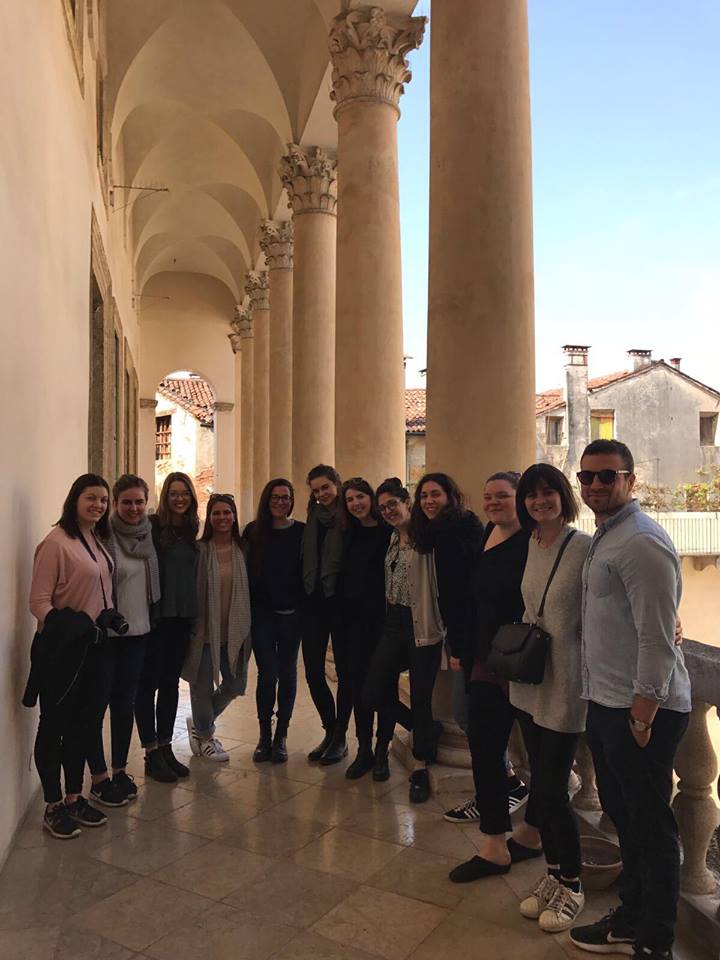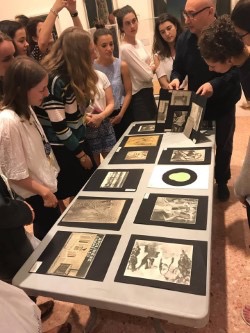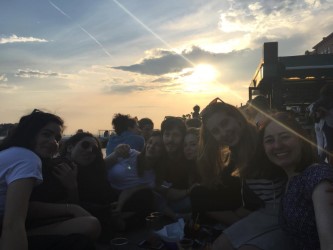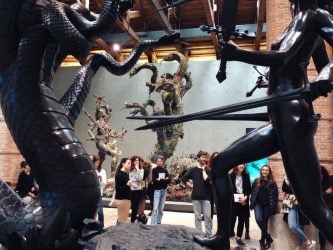“Having plenty of time and the museum’s funds at my disposal, I put myself on a regime to buy one picture a day.”
– Peggy Guggenheim, 1947, on amassing her collection in Paris
I walked up the crooked stone steps to the small entrance vestibule and was greeted by a dapper young man in a suit. I extended my hand with forced confidence and introduced myself as one of the new interns. After an exchange of pleasantries, he grinned goofily and motioned to the faded terracotta palazzo to his right. Like countless guests before and after me I asked him where the bathroom was…
My name is Hella Wiedmer-Newman and from April to June 2017 I was an intern at the Peggy Guggenheim Collection in Venice. The PGC is one of Europe’s most beloved modern art museums, due to both Peggy Guggenheim’s biography and the unique works on display there. The museum was established in 1980; it had served as the collector’s private home from 1949 to 1979 when Guggenheim died after a career as one of the 20thcentury’s most important art collectors and patrons. Her friend Philip Rylands helped turn her former residence into a museum (the collection was bequeathed to the Solomon R. Guggenheim Foundation under the condition that it remain in Venice). He served as director until June 2017 when Karole Vail, Peggy’s granddaughter and a curator at the Guggenheim in New York, took over.


The internship program employs 25 to 30 interns at a time for stays of one to three months. Interns change monthly; when there is a last-minute cancellation, others can apply to stay an extra month. As an intern, I got to perform all the jobs that make a museum tick: I guarded rooms, sold and cancelled tickets, distributed audio-guides, checked coats and staffed special events; cleaned windows, sculptures and benches; secured protective coverings for light-sensitive paintings and drawings, and replenished the gift shop. I also delivered at least five public talks a month on Guggenheim’s life, as well as individual artworks and movements represented in the collection and current exhibitions. During my internship, the exhibitions included the surrealist period of Rita Kerrn-Larsen and a retrospective of the works of the anti-abstract expressionist Mark Tobey. I also gave tours of the entire collection in English and German, remunerated with EUR 60 (unless it was for friends of the museum). At first, speaking in front of an audience of strangers can seem daunting and it takes a few tries to master: in my very first talk I got so flustered trying to explicate a painting of a nude woman riding a bicycle that I blurted out: “It’s like what Freud says about dreams and wish fulfillment; I mean, haven’t you ever had that dream where you’re naked in public, I know I have it all the time?!”
At the end of our respective stays, each of us had to deliver a 30-minute seminar. They didn’t have to take the form of a traditional academic paper, but were rather a way of introducing the other interns to something new, or a chance to explore something related to Venice. My seminar addressed the narrative and affective capabilities of Virtual Reality, a notable theme at this year’s Biennale.
Not all my time as an intern was work. E very month we had at least one lecture with a curator, conservator/restorer, or administrator, and a tour or lecture led by Dr. Rylands himself. We also took two trips as a group each month: a Venice trip to a local event, and a big trip beyond Venice. Highlights this summer were the Damien Hirst exhibition at the Punta della Dogana and the Palazzo Grassi, and Palladio’s Teatro Olimpico in Vicenza. At the beginning of every month there was a welcome breakfast and dinner for the new interns and at the end the Festa della Fine del Mese, a potluck on the museum’s famous roof-top terrace. We would also enjoy the odd spritz by the grand canal after work, and occasional house parties and group dinners were common. Many of us also visited other parts of Italy during our stay.
But, most importantly, celebrities often visit the museum. In my last month, I spotted Anne Hathaway walking around the Anthony Caro dressed entirely in white and sporting a blue baseball cap, and, as was the custom, I immediately alerted everyone to her whereabouts. We all piled into the special exhibition space and one of us started doing a pretend tour, which actually garnered a few interested nods from Anne herself – yeah, we’re on a first name basis now.


I am often asked about salary, admission and life in Venice. The salary is EUR 800/month, which just covers rent of one of the rooms on a list sent out to interns before their arrival, and basic food. It helps if you have some money saved. I found a room in the apartment of a lovely couple, but others were not so lucky and housing was a constant topic of discussion. The application is a straightforward online process requiring two recommendations, a résumé and a short essay on one’s interest in the collection. One can specify a desired length of time (one to three months) or specific months, though the final decision rests with the PGC. It is helpful if one speaks languages other than English, especially French, Italian or German. And finally, perseverance pays off: many interns are accepted only after a second or even third try.
Living in Venice is overwhelming, in the best possible way. Especially during the tourist season and, more importantly, the Biennale, the crowds were initially daunting. But, though it was annoying at times to walk through the streets already crowded at 7:30 am – not a day went by that I didn’t see a new bride with her entire wedding party scouring the Piazza San Marco for the perfect backdrop to her photos — there are many secluded areas and nice, cheap restaurants where tourists seldom venture. (One of my favourite bars is called Adriatico Mar; they serve artisanal rhubarb spritz, need I say more?!) I was also delighted by the vast number of art spaces in Venice, not just during the Biennale. Venice swells your soul and, in a tiny way, changes you forever.
Among other things — patience, for instance, and decorum and pragmatism — the internship taught me a new comfort with researching and crafting texts on a range of topics in a very short time, and presenting them to strangers. It was also a welcome challenge to work with so many people from different countries and, as a precious side effect, to form friendships with some. The PGC internship is a truly singular opportunity; it has enriched me in many different ways and left me feeling more fully sculpted than when I first ascended those crooked stone steps.
If you have any questions about the application process, the internship itself or Venice, please do not hesitate to contact me: hella.wiedmer.newman@mail.utoronto.ca
Here is a link to the 2018 internship application form: http://www.guggenheim-venice.it/inglese/education/pdf/internship-form.pdf


